- MathNotebook
- MathConcepts
- StudyMath
- Geometry
- Logic
- Bott periodicity
- CategoryTheory
- FieldWithOneElement
- MathDiscovery
- Math Connections
Epistemology
- m a t h 4 w i s d o m - g m a i l
- +370 607 27 665
- My work is in the Public Domain for all to share freely.
- 读物 书 影片 维基百科
Introduction E9F5FC
Questions FFFFC0
Software
Culture • Cognition • Communication (Inter)cultural perspectives on language and the mind (ICPLM 2017), September 14-15, Lublin, Poland
How Do Things Come to Matter?
Evolution of Self-Identity in the Intercultural Debate on Whether to Restore Vilnius's Oldest Jewish Cemetery.
Key words: Argumentation, self-identity, origins of language, pattern language, Litvak heritage
In Vilnius, Lithuania, a controversy unfolds over whether to convert a Soviet Sports Palace into a European Convention Center, or whether to restore the Jewish cemetery which the Soviets desecrated there. We take the opportunity to analyze the origins of related self-definitions, decisions, positions and questions which matter for various self-identities: the Soviet government, Soviet Lithuanian architects, real estate developers, post-Soviet Lithuanians, anti-Soviet Lithuanians, post-anti-Soviet Lithuanians, the Lithuanian government, the Lithuanian Jewish community's official leaders, orthodox Lithuanian Jews and local residents.
We illustrate how self-identity gets extended with 12 different contexts:
- states of being, doing or learning;
- perspectives of a person, of "people", and of beyond this world;
- accepting a world, entering a world, or listening outside one's world;
- rejecting a context, acknowledging it conditionally, and allowing for parallel contexts.
We describe some of the "equations" by which these contexts are further composed. We look for parallels with universal constructs in natural language and explore how these constructs (such as the distinction between nouns, verbs and modifiers) might arise from a grammar of self-identity which defines why and how we identify with issues, why and how they matter to us or not.
We note especially that peace is the healthy reference point for Why we should act? We can then study our emotions as deviations from peace which clarify for us the boundary between our self and our world, and also reveal whether we are expecting what we truly wish. Architect Christopher Alexander calls this peace "the quality without a name". His pattern languages foster it, and his 15 properties of life enhance it. We show that 3 of these properties (strong centers, strong boundaries, levels of scale) are manifested by the other 12, which match with our 12 contexts which extend self-identity. Adding contexts tell us How do we behave? but removing them tells us Why do we behave? We can care even when we can't take action, and thus the behavioral question, How do we behave? is incomplete without the additional moral question, How should we behave?
Drafts
Culture • Cognition • Communication (Inter)cultural perspectives on language and the mind (ICPLM 2017), September 14-15, Lublin, Poland

How Do Things Come to Matter?
Evolution of Self-Identity in the Intercultural Debate on Whether to Restore Vilnius's Oldest Jewish Cemetery.
My Topic
- Introduce the problem: How Do Things Come to Matter? as applied to the particular case of restoring Vilnius's Oldest Jewish Cemetery. Why won't we empathize with Jews? The question of how empathy can arise, and how identity can be changed?
- The answer is that it is not our old identity or new identity that matters but our true identity is our readiness to let go of our identity.
- Will share some tentative ideas.
- Will start with some insights from this practical issue. Will consider them in terms of culture, communication and cognition. And then will return with some concluding insights.
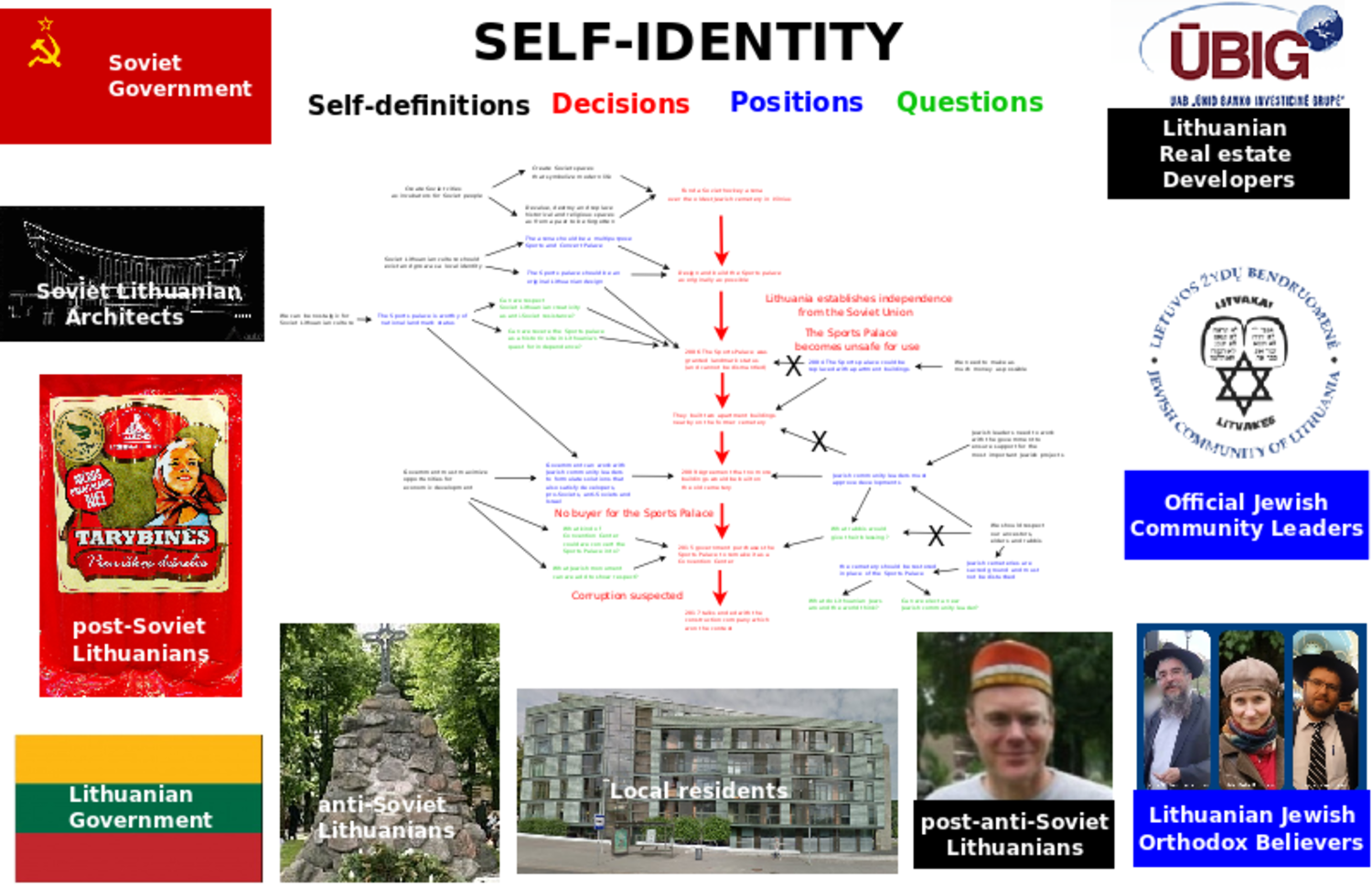
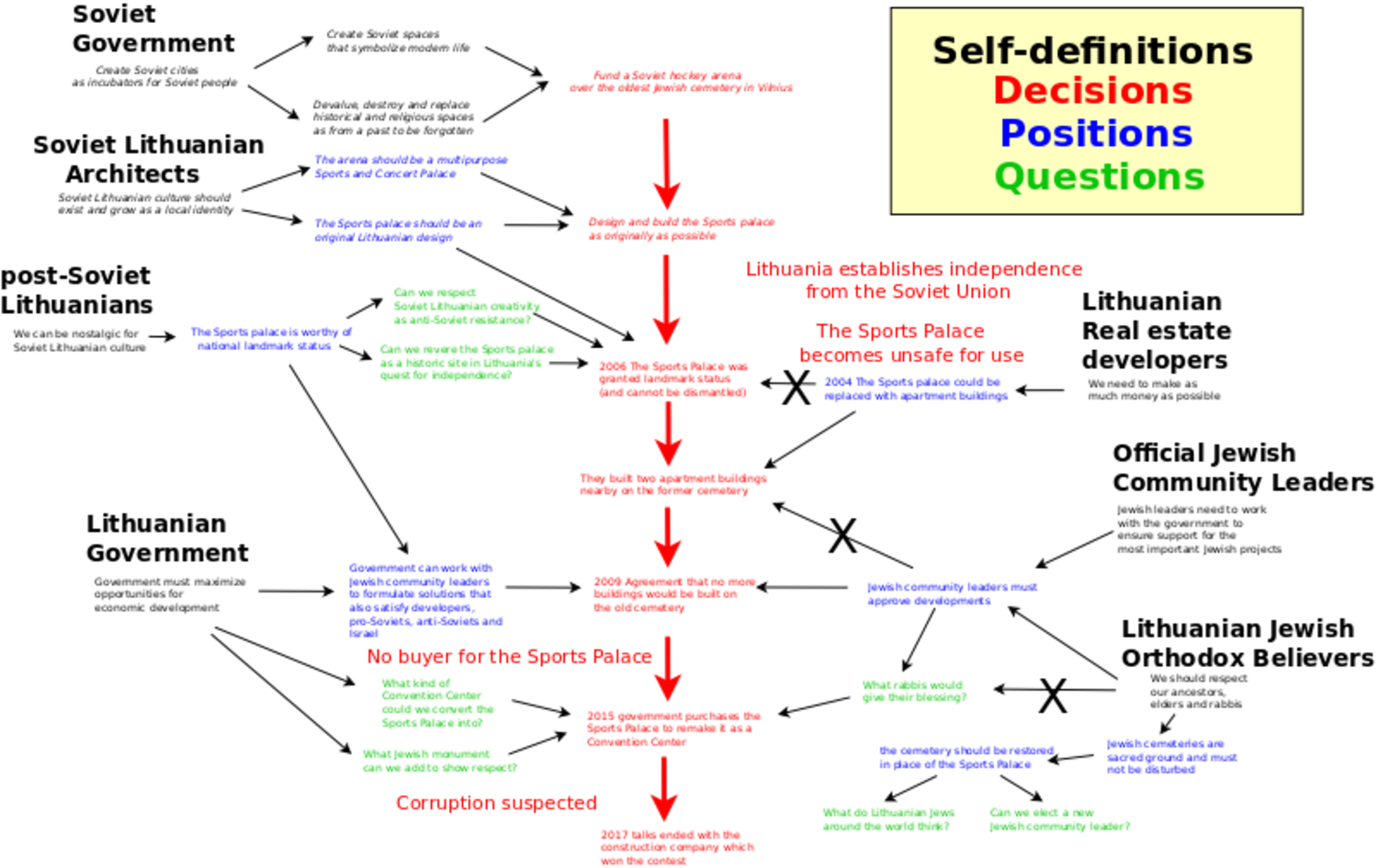
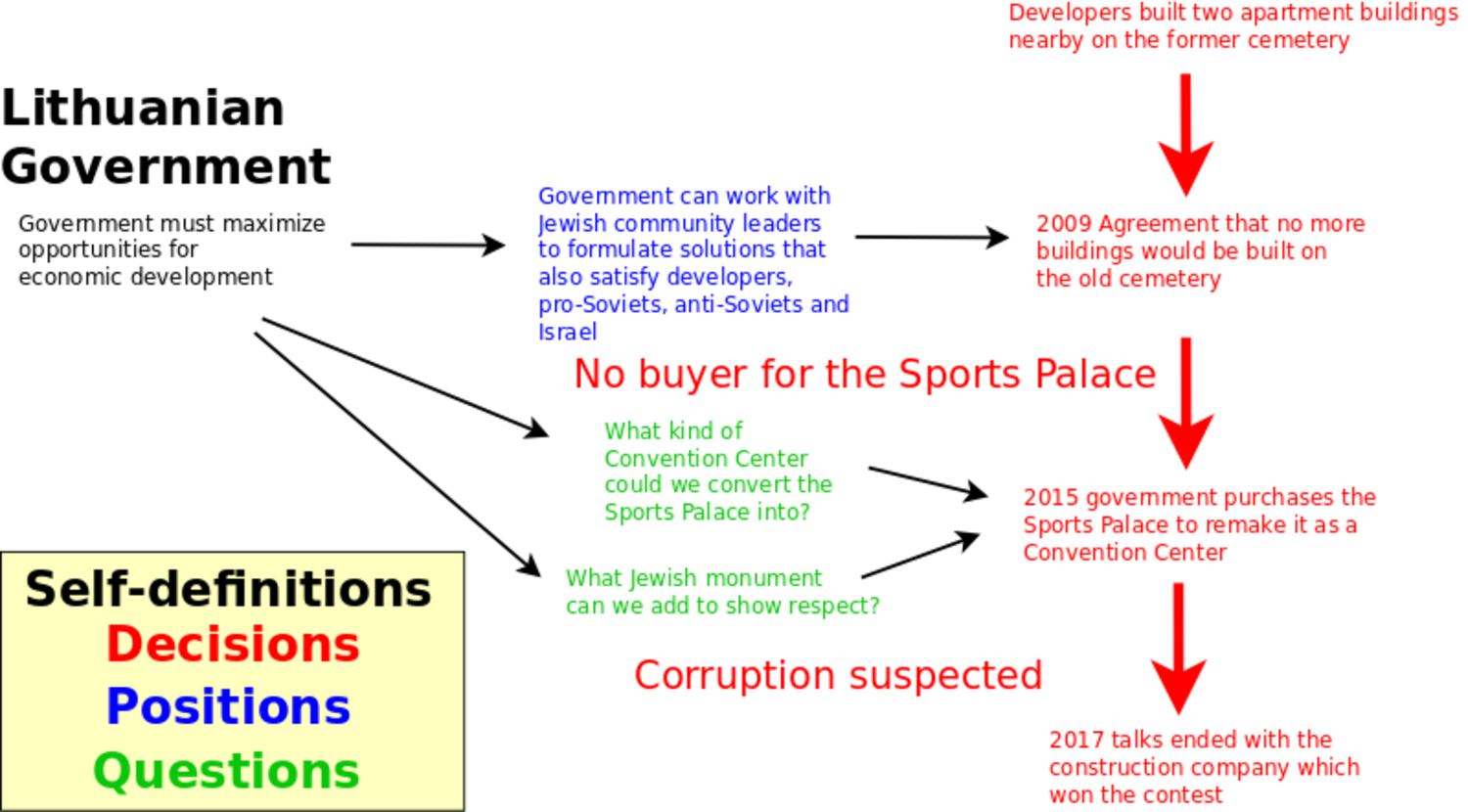
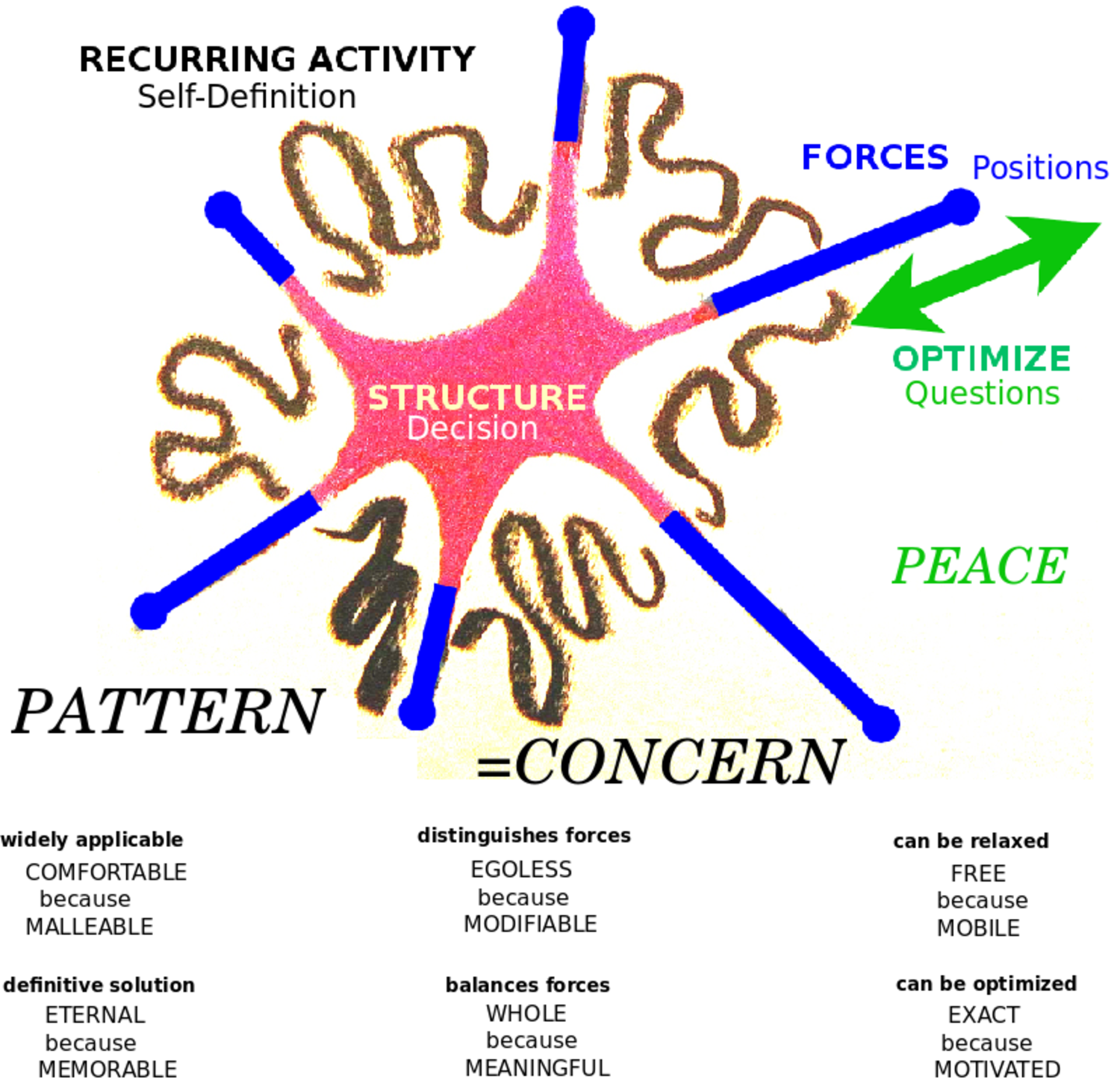
Static Caring (Solutions): Concerns as Patterns
- Draw a map of the many points of view. Can think of a "concern" in terms of
- How our identity is related to our points of view.
- In Vilnius, Lithuania, a controversy unfolds over whether to convert a Soviet Sports Palace into a European Convention Center, or whether to restore the Jewish cemetery which the Soviets desecrated there. We take the opportunity to analyze the origins of related self-definitions, decisions, positions and questions which matter for various self-identities: the Soviet government, Soviet Lithuanian architects, real estate developers, post-Soviet Lithuanians, anti-Soviet Lithuanians, post-anti-Soviet Lithuanians, the Lithuanian government, the Lithuanian Jewish community's official leaders, orthodox Lithuanian Jews and local residents.
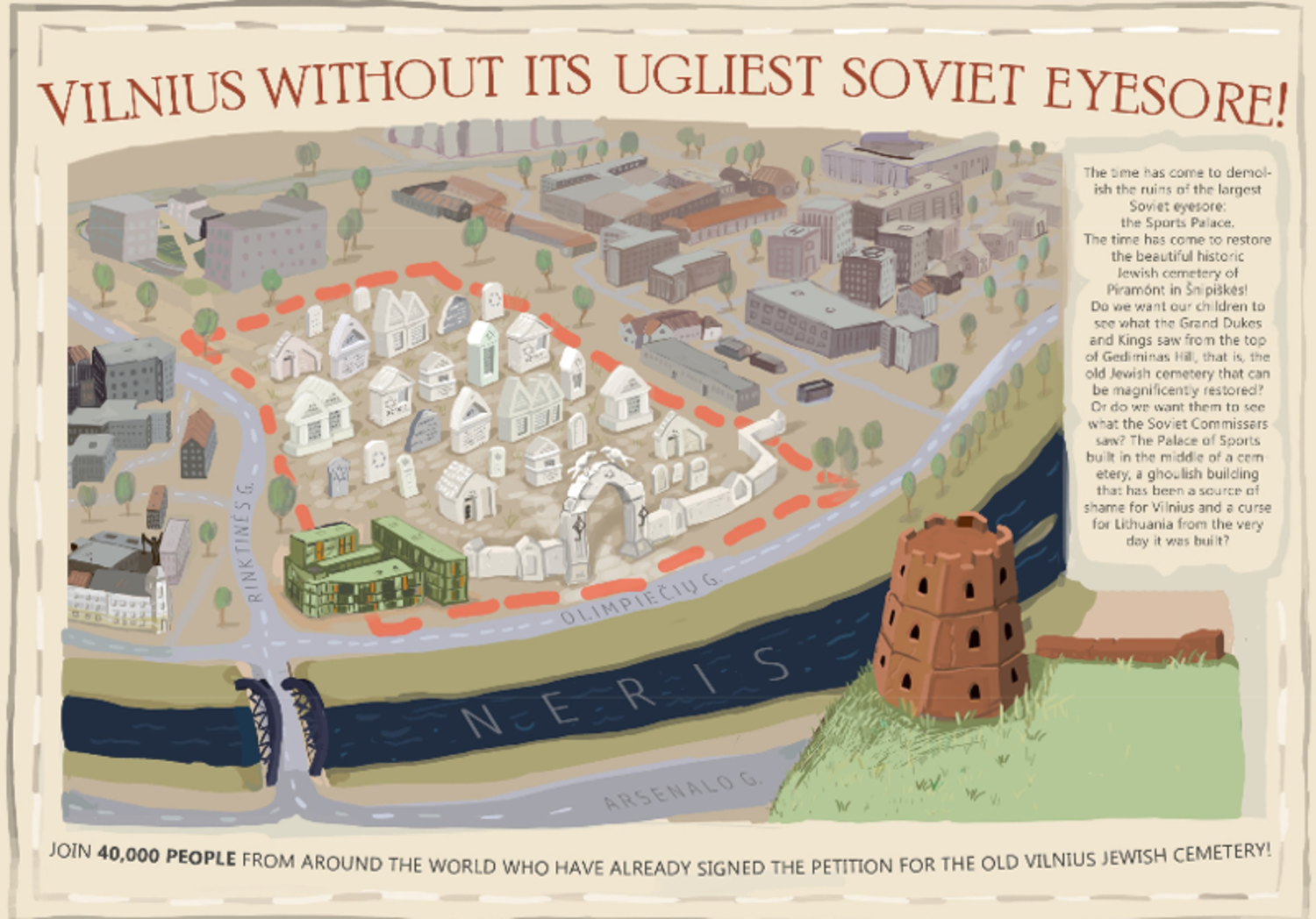
Christopher Alexander's pattern language - a pattern or solution.
- Consider the pattern on four different levels. Note that self-definition is impossible to change but questions are easy to change.
- Pattern: view from Gediminas castle - skyline - historic panorama of heritage
- Pattern: cherish spiritual capital (Hill of Crosses)
- Alexander also gives wholeness or peace as a clue. Define peace in terms of emotions.
- The human condition for individuals will always be different. In our culture, we can grow to share and overlap in our activities. But we can share a symbol - like the view of the cemetery from Gediminas's castle - although we can identify with it from our own personal perspective. A symbol can unite opposing perspectives.
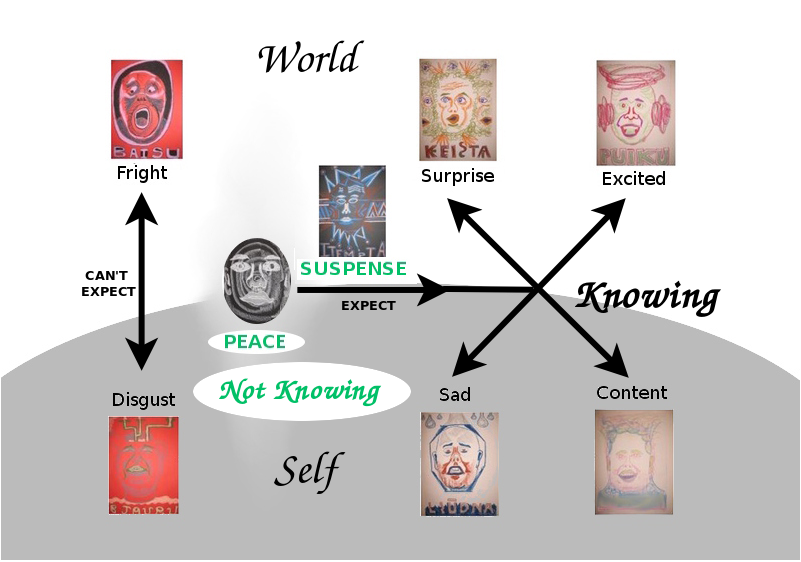
Peace - Letting Go of One Self
- Our emotional life defines the boundary between our self and our world. Peace - the lack of expectations - is the absence of distinction between what we know well and what we don't know well - it is the ability to leave not knowing - to let go of our knowledge, let go of our values.
- We can then study our emotions as deviations from peace which clarify for us the boundary between our self and our world, and also reveal whether we are expecting what we truly wish.
- Savastis kyla iš paskiro žmogaus jausmų - o išrišimas, ramybe, iš bendro žmogaus. Ramybė iškyla permąstant bendru žmogumi, bendra veikla. Rūpestis, tai paskiro žmogaus išskirtinis reikalas.
- So we won't let go of what we identify with our self - we need to have it be more distant before we can change - then we can lock it back in.
- Now consider how identity is locked in or let go of.
- Freedom of defining our self! specify this... we are not entrenched (implicit) but we are the peace in the explicit - we are revealed - we lay ourselves down and we pick ourselves back up again
Paradox
- We don't know but we are creatures of knowing
- We use our deepest value to make our way forward - we take a stand, follow through, and reflect
- But is our deepest value correct? No! So we keep adjusting it with questions.
- Freedom to correct ourselves is the freedom to go astray. How do we and how should we behave.
- So people of many different values - personal cultures.
Growth Experiences - Letting Go of Old Self to Take Up New Self - Complement to Self
- Communication: Collected meaningful experiences - where I grew - for improv comedy. Change in self-identity: old self, new self and complement-to-self. Example of Lacie Diaz. (Relate instead to my experience of Litvak culture?)
- One-time events
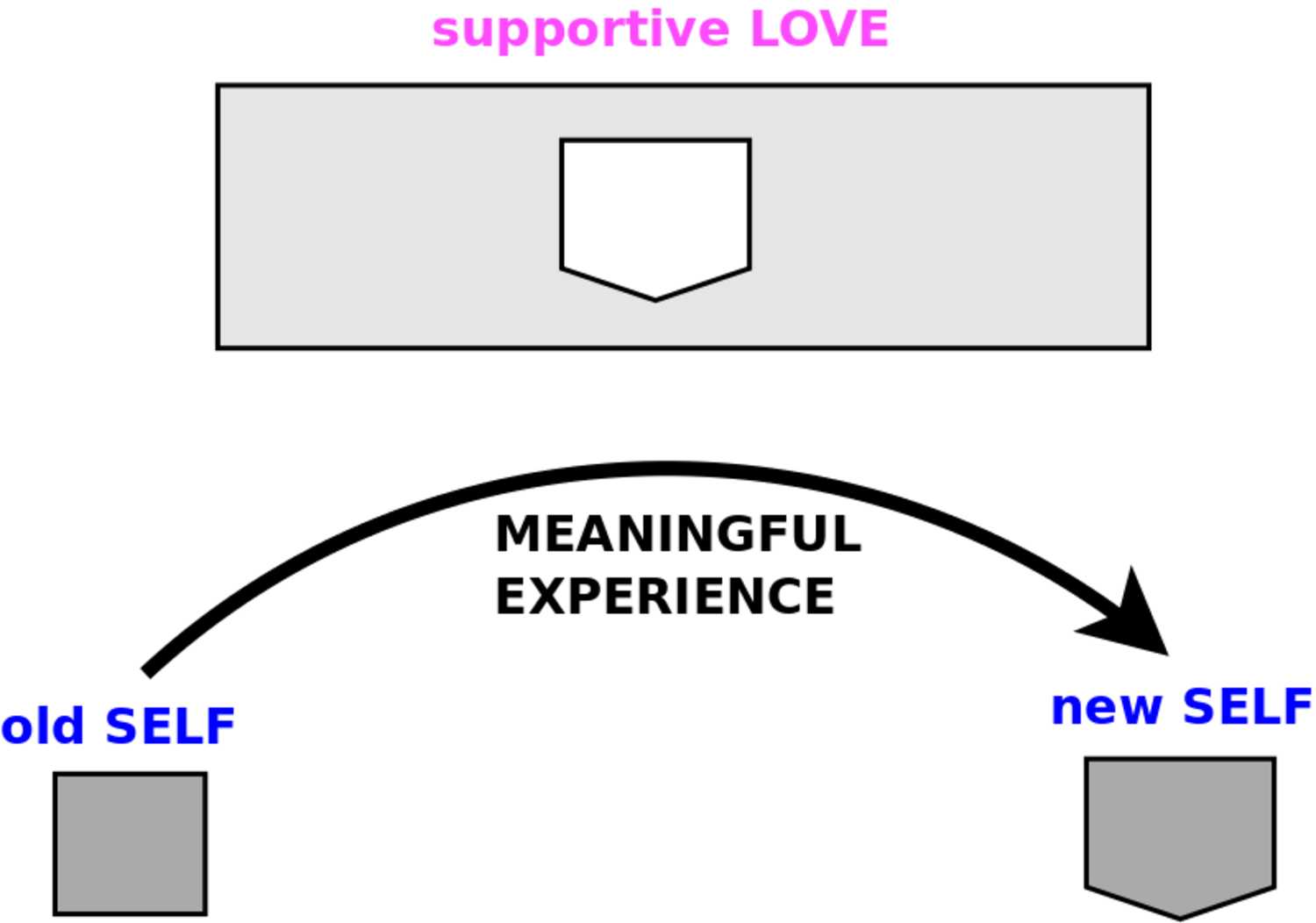
Importance of letting go of one's self.
- Six different types of growth - and my art project God's Face.
- Six questions for sharpening one's deepest value.
- Consider the six (of eight) questions that sharpen values (from the Eightfold Way) and relate them to the six experiences. Three ask How to apply a value: at all, for oneself, and more broadly, and three ask Why the value does not exist, we don't live it, we don't think it? This is 3+3 whereas the kinds of concerns is given by +2. In either case, we can think of the old self giving rise to the new self by way of the opposite self. On the one hand, this gives three positives and three negatives. But on the other hand, we can interpret this as one old positive, one new positive, and four others - the negative ones and the positive present - yielding 2+4.
- Concerns:Kinds of mistakes that we can make
- Properties of signs - requirements of patterns - names of the "quality without a name"
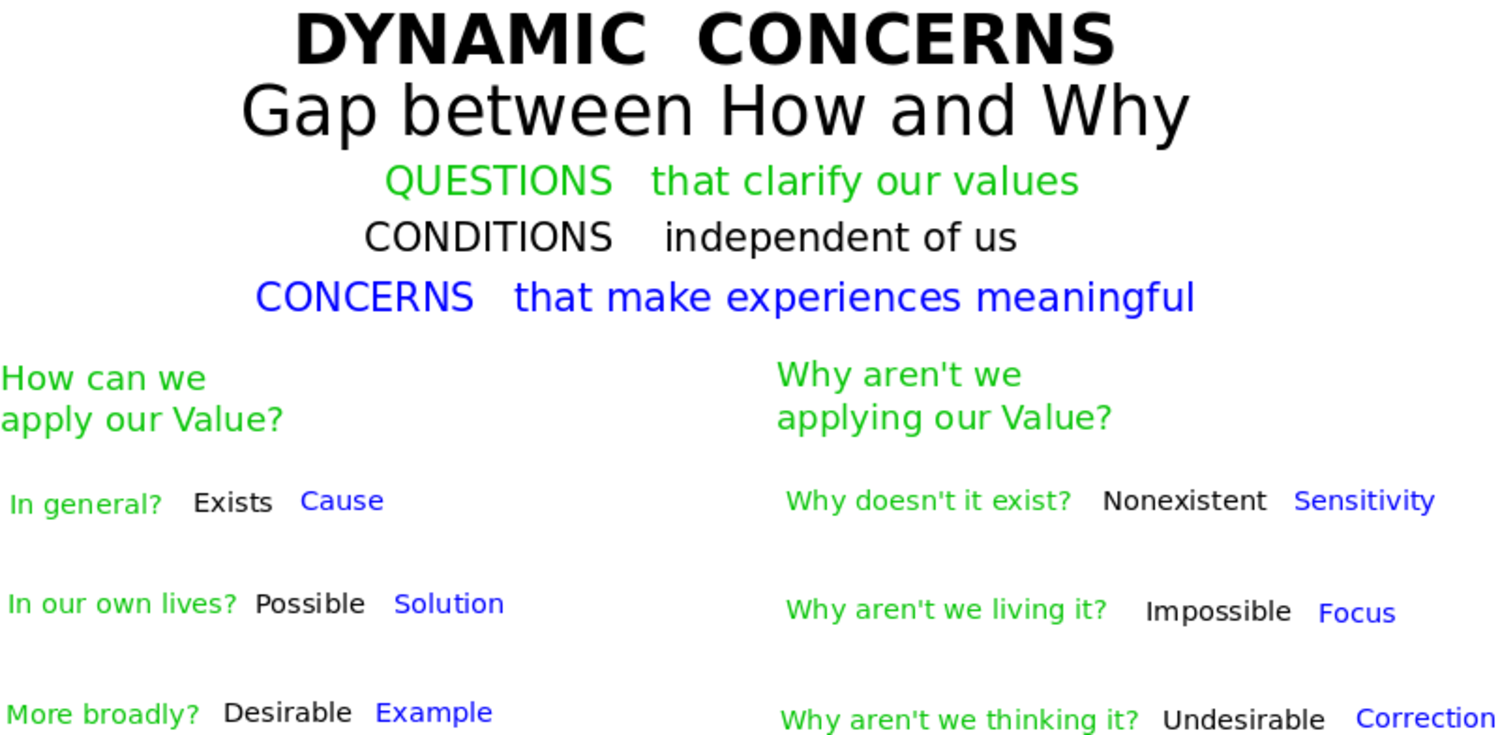
Duality of language
- Coordinating activity vs. building assemblies
- Reducing vagueness
- Divisions of everything
- We are attached to assemblies - to particular perspectives - but let go by considering the overall frameworks.
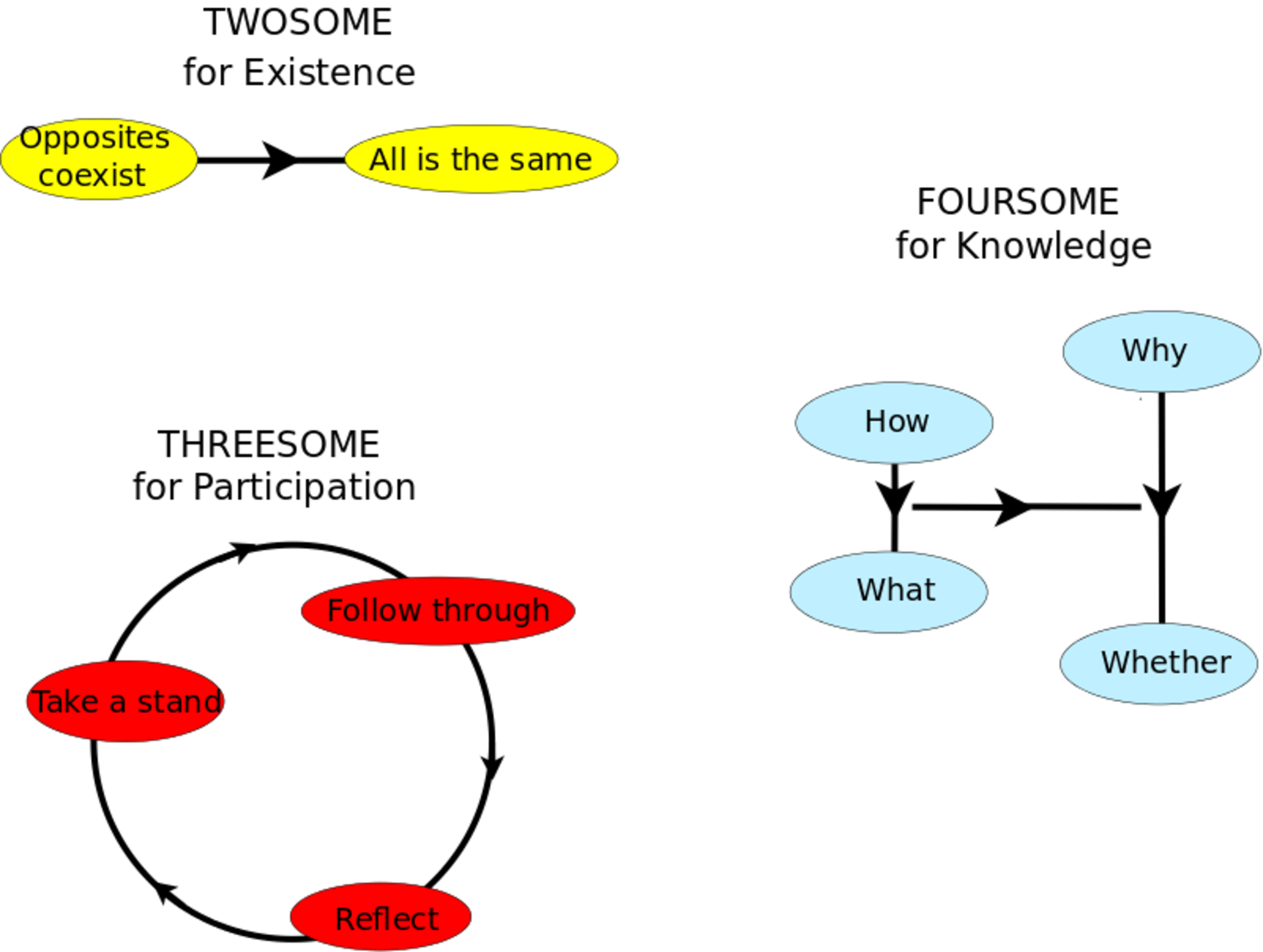
Implicit, recurring activity and explicit, one-time activity (concern)
- Cognition - Relate this to fundamental cognitive frameworks. Divisions of everything. Define 12 fundamental circumstances - vocabulary of the imagination.
- Circumstances as what is not.
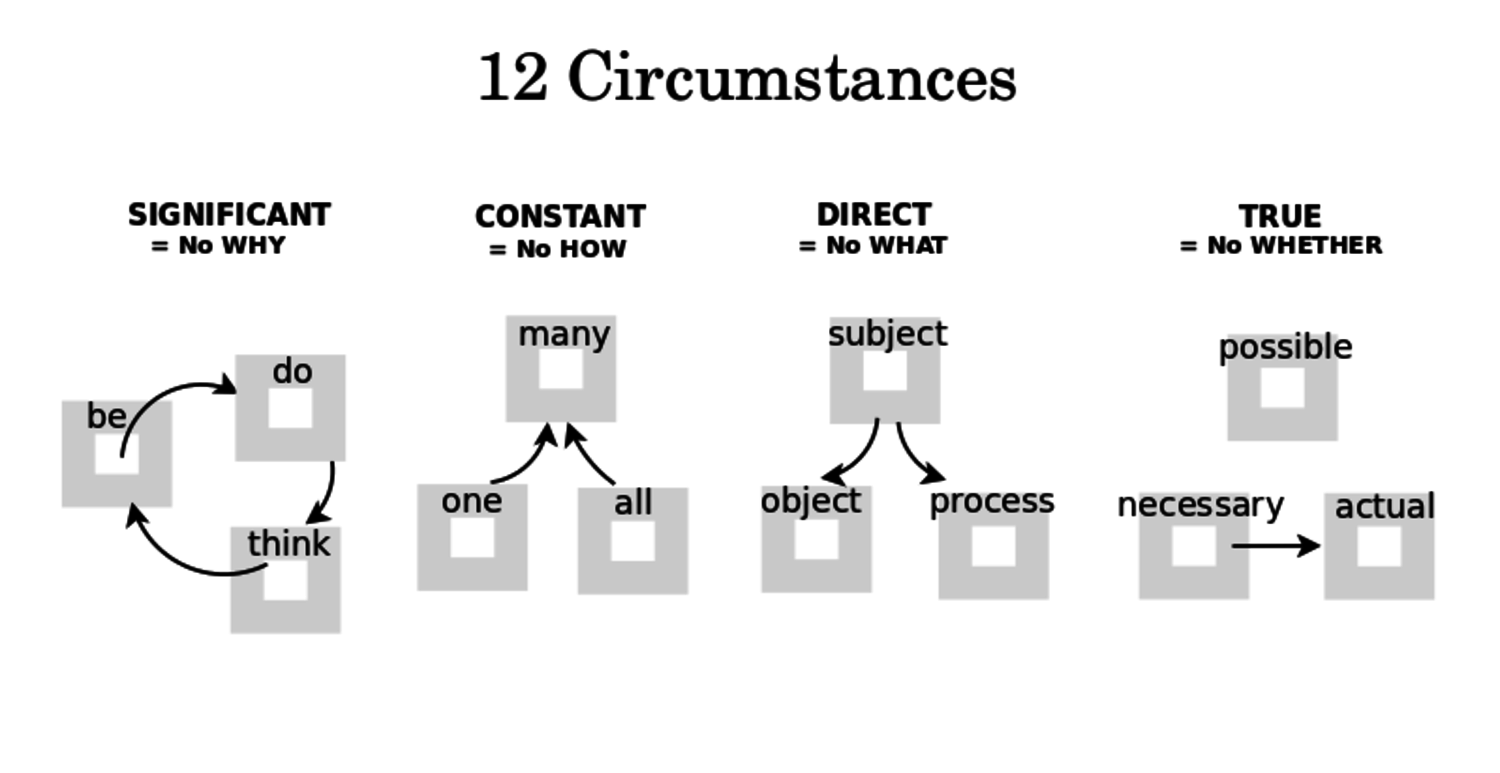
- Circumstances go from most implicit to most explicit.
- The difference is that the implicit three-cycle is not negatable whereas the explicit threesome is negated. And the latter gives the six types of growth.
- Furthermore, the relationship between activity and self, what is not and what is.
- Thus the three-cycle locks in the self and the explicit threesome lets us let go and then we can lock it in again.
- The types of experiences are based on necessary-actual-possible understood both positively and negatively, whereas being-doing-thinking cannot be negated.
- The implicit "fate" of our self - and the explicit "freedom" of our self - we can identify with being or not-being - with self or love - with one or all.
- This identification takes place by way of a map from content to form. Mapping the threesome content (poslinkis in the three-cycle) onto form (būtinas-tikras-galimas). The map can be onto the positive or onto the negative. And with regard to what is, or what is not.
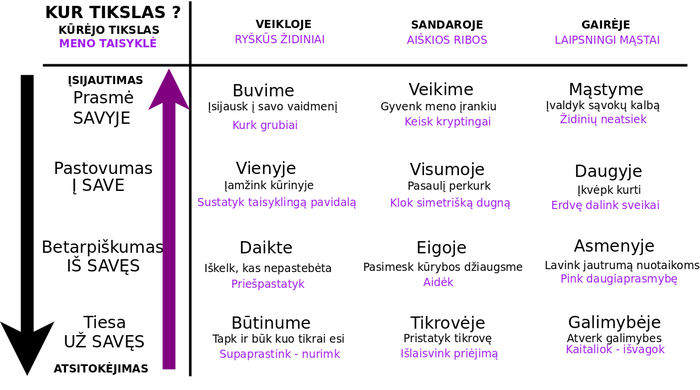
Purposes of Art and Rules for Art
- 12 purposes of art - stepping out
- Coming from a sense of peace - healthy art vs. unhealthy art
- We note especially that peace is the healthy reference point for Why we should act?
- Architect Christopher Alexander calls this peace "the quality without a name".
- finding the nullsome - healthy
- then playing the mind game - immersing
- 12 rules of art - 12 principles of life - stepping in
- His pattern languages foster it, and his 15 properties of life enhance it. We show that 3 of these properties (strong centers, strong boundaries, levels of scale) are manifested by the other 12, which match with our 12 contexts which extend self-identity.
- Stepping out into peace, then stepping in to be riled by life.
- Adding contexts tell us How do we behave? but removing them tells us Why do we behave? We can care even when we can't take action, and thus the behavioral question, How do we behave? is incomplete without the additional moral question, How should we behave? What is our self? What do we choose our self to be - all or separate?
One-time activity
- One-time activity is the relating of recurring activity, old and new.
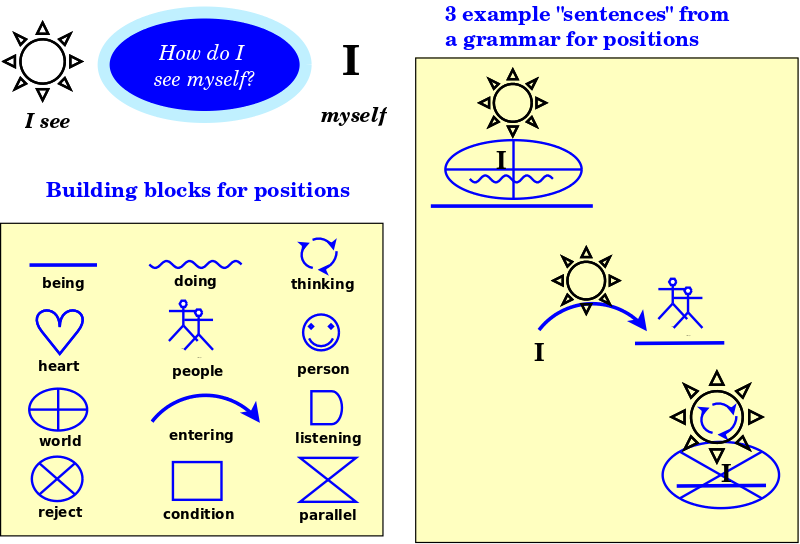
Change in Self-Identity - Challenge: trying to make sense of the equations
- A workshop on changes in self-identity gave equations built from these building blocks.
- The 12 circumstances are the same as the building blocks for self-identity.
- An example of an equation from our lives...
- Identifying with a vantage point (our own or somebody else's) between the old self and the new self.
- The equation includes stepping out - vantage point - and stepping in.
- tapatybės kaitos lygtys
- We illustrate how self-identity gets extended with 12 different contexts:
- states of being, doing or learning;
- perspectives of a person, of "people", and of beyond this world;
- accepting a world, entering a world, or listening outside one's world;
- rejecting a context, acknowledging it conditionally, and allowing for parallel contexts.
- We describe some of the "equations" by which these contexts are further composed.
Activity as basis for language
- We look for parallels with universal constructs in natural language and explore how these constructs (such as the distinction between nouns, verbs and modifiers) might arise from a grammar of self-identity which defines why and how we identify with issues, why and how they matter to us or not.
Attach:MusuIrDievoRupesciai.png Δ
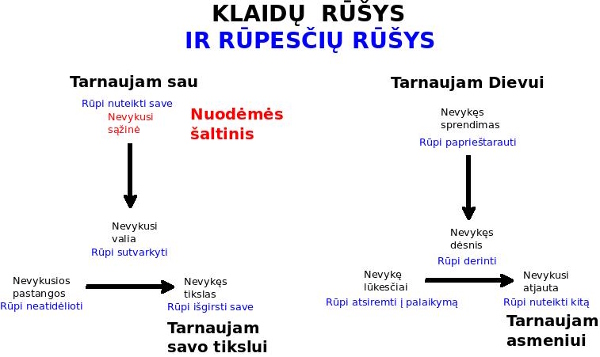
Active Caring (Problems): Caring and Maturing
- Caring as an activity by which we relate our self with our self. A workshop on what we care about.
- If we can only go beyond ourselves into ourselves: How we escape ourselves, go beyond ourselves: Identifying ourselves with the activity of transforming ourselves.
- Our episodes of maturing as what God cares about - the sense of peace and wholeness
- Ambiguity important - we care (stepped in) but also God cares (stepped out) through us - and we mature
- Ramybe žmogaus rūpestis tampa žmogaus branda, tai siejama su gyva veikla, ramybe. Rūpestis yra vienkartinei veiklai, išskirtinei veiklai. Pasikartojant veiklai, tai savaime tvarkosi - taip tampa įvardijamu.
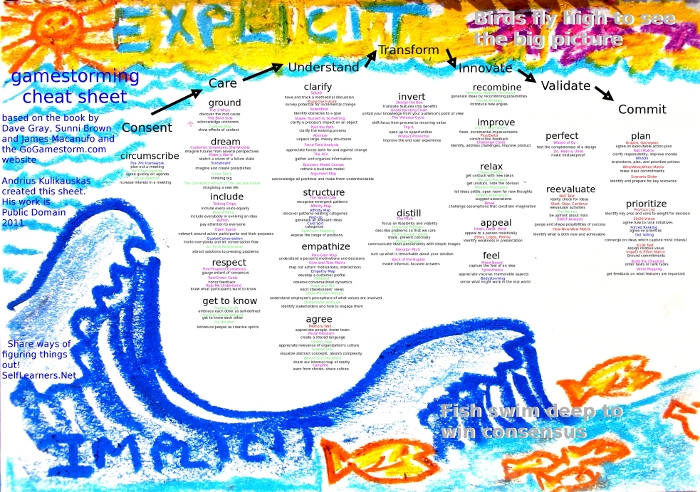
Gamestorming
- Process of commitment
- Specifically turning the view around
- Implicit and explicit
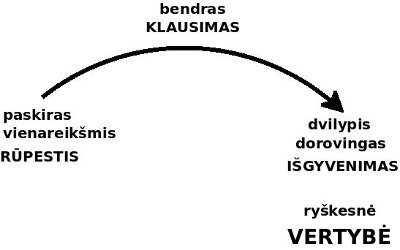
Converting concerns, old and new, into one-time growth experiences which link them.
Survey
- Pro-Litvak point of view: Jews as victims - Reactive (stepping out) vs. pro-Lithuanian point of view: Lithuanians as former and potential perpetrators - Proactive (stepping in). Need both points of view - and a shift in the point of view - transform from the pro-Litvak point of view to the pro-Lithuanian point of view.
- Pro-Litvaks believe that Jews are hurt and vulnerable. But they don't emphasize this.
Conclusion
- Jonas Mekas problem and solution... but people value information - knowing Jews, information stands, - this may be superficial but it is precisely that which lets people let go of their own self and define themselves one way or the other - the real problem is ignorance? The crucil point is the ability to ask questions - to not know - the significnance of the world and the source of peace. Questioning - engaging the truth. Our ability to live amongst knowledge. The knowledge that there are Jews.
20170914CultureCognitionCommunication-Abstract
Tyrimas
- Apžvelgti pagrindimą - kaip ima rūpėti.
- Surinkti daugiau pavyzdžių iš savo gyvenimo, kaip tapatybė praturtinama.
- Išryškinti 12 būdų.
- Suvokti tapatybės kaitos lygtis, kaip jos susilipdo savotiška kalba.
- Suvokti kaip žmonių nuostatos sporto rūmų klausimu susiję su jų tapatybėmis.
- Suvokti kaip gali keistis žmonių tapatybė, nuostatos, savastis ir atjauta.
- Suvokti kaip tam yra svarbus atsitokėjimas, ramybė ir įsitraukimas.
- Atsitokėjimą ir įsitraukimą susieti su kūrybos prasme ir kūrybos taisyklėmis.
- Susieti su Gamestorming žaidimais.
- Susieti su rūpesčiais ir su branda (Dievo rūpesčiais).
- Kažką išvesti iš savo apklausos.
- Kalba kaip (vienkartinės ir pasikartojančios) veiklos derinimas.
My Topic
- Introduce the problem: How Do Things Come to Matter? as applied to the particular case of restoring Vilnius's Oldest Jewish Cemetery. Why won't we empathize with Jews? The question of how empathy can arise, and how identity can be changed?
- The answer is that it is not our old identity or new identity that matters but our true identity is our readiness to let go of our identity.
- Will share some tentative ideas. Will consider them in terms of culture, communication and cognition.
Paradox
- We don't know but we are creatures of knowing
- We use our deepest value to make our way forward - we take a stand, follow through, and reflect
- But is our deepest value correct? No! So we keep adjusting it with questions.
- So people of many different values - personal cultures.
Static Caring (Solutions): Concerns as Patterns
- Draw a map of the many points of view. Can think of a "concern" in terms of Christopher Alexander's pattern language - a pattern or solution.
- Consider the pattern on four different levels. Note that self-definition is impossible to change but questions are easy to change.
- Pattern: view from Gediminas castle
- Pattern: cherish spiritual capital (Hill of Crosses)
- Alexander also gives wholeness or peace as a clue. Define peace in terms of emotions.
Peace - Letting Go of One Self
- Our emotional life defines the boundary between our self and our world. Peace - the lack of expectations - is the absence of distinction between what we know well and what we don't know well - it is the ability to leave not knowing - to let go of our knowledge, let go of our values.
- So we won't let go of what we identify with our self - we need to have it be more distant before we can change - then we can lock it back in.
- Now consider how identity is locked in or let go of.
- Freedom of defining our self! specify this... we are not entrenched (implicit) but we are the peace in the explicit - we are revealed - we lay ourselves down and we pick ourselves back up again
Growth Experiences - Letting Go of Old Self to Take Up New Self - Complement to Self
- Communication: Collected meaningful experiences - where I grew - for improv comedy. Change in self-identity: old self, new self and complement-to-self. Example of Lacie Diaz. (Relate instead to my experience of Litvak culture?) Importance of letting go of one's self.
- Six different types of growth - and my art project God's Face.
- Six questions for sharpening one's deepest value.
Implicit, recurring activity and explicit, one-time activity (concern)
- Cognition - Relate this to fundamental cognitive frameworks. Divisions of everything. Define 12 fundamental circumstances - vocabulary of the imagination.
- Circumstances as what is not.
- Circumstances go from most implicit to most explicit.
- The difference is that the implicit three-cycle is not negatable whereas the explicit threesome is negated. And the latter gives the six types of growth.
- Furthermore, the relationship between activity and self, what is not and what is.
- Thus the three-cycle locks in the self and the explicit threesome lets us let go and then we can lock it in again.
Purposes of Art and Rules for Art
- 12 purposes of art - stepping out
- 12 rules of art - 12 principles of life - stepping in
Change in Self-Identity - Challenge: trying to make sense of the equations
- A workshop on changes in self-identity gave equations built from these building blocks.
- The 12 circumstances are the same as the building blocks for self-identity.
Active Caring (Problems): Caring and Maturing
- Caring as an activity by which we relate our self with our self. A workshop on what we care about.
- If we can only go beyond ourselves into ourselves: How we escape ourselves, go beyond ourselves: Identifying ourselves with the activity of transforming ourselves.
- Our episodes of maturing as what God cares about - the sense of peace and wholeness
Gamestorming
- Process of commitment
- Specifically turning the view around
- Implicit and explicit
Survey
- Reactive (stepping out) vs. Proactive (stepping in)
Conclusion
- Jonas Mekas problem and solution... but people value information - knowing Jews, information stands, - this may be superficial but it is precisely that which lets people let go of their own self and define themselves one way or the other - the real problem is ignorance? The crucil point is the ability to ask questions - to not know - the significnance of the world and the source of peace. Questioning - engaging the truth. Our ability to live amongst knowledge. The knowledge that there are Jews.
- The human condition for individuals will always be different. In our culture, we can grow to share and overlap in our activities. But we can share a symbol - like the view of the cemetery from Gediminas's castle - although we can identify with it from our own personal perspective. A symbol can unite opposing perspectives.
Mapping the threesome content (poslinkis in the three-cycle) onto form (būtinas-tikras-galimas). The map can be onto the positive or onto the negative. And with regard to what is, or what is not.

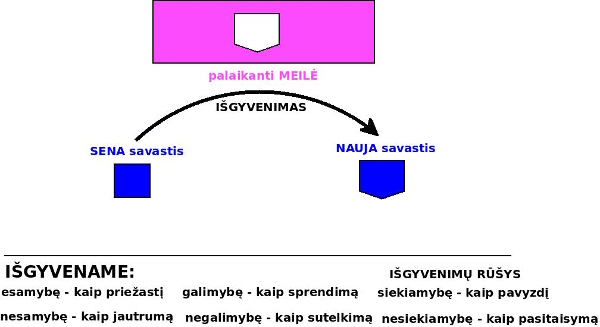
Attach:MusuIrDievoRupesciai.png Δ

The types of experiences are based on necessary-actual-possible understood both positively and negatively, whereas being-doing-thinking cannot be negated.
Consider the six (of eight) questions that sharpen values (from the Eightfold Way) and relate them to the six experiences. Three ask How to apply a value: at all, for oneself, and more broadly, and three ask Why the value does not exist, we don't live it, we don't think it? This is 3+3 whereas the kinds of concerns is given by +2. In either case, we can think of the old self giving rise to the new self by way of the opposite self. On the one hand, this gives three positives and three negatives. But on the other hand, we can interpret this as one old positive, one new positive, and four others - the negative ones and the positive present - yielding 2+4.
Savastis kyla iš paskiro žmogaus jausmų - o išrišimas, ramybe, iš bendro žmogaus. Ramybė iškyla permąstant bendru žmogumi, bendra veikla. Rūpestis, tai paskiro žmogaus išskirtinis reikalas.
Ramybe žmogaus rūpestis tampa žmogaus branda, tai siejama su gyva veikla, ramybe. Rūpestis yra vienkartinei veiklai, išskirtinei veiklai. Pasikartojant veiklai, tai savaime tvarkosi - taip tampa įvardijamu.
Culture • Cognition • Communication (Inter)cultural perspectives on language and the mind (ICPLM 2017), September 14-15, Lublin, Poland
How Do Things Come to Matter?
Evolution of Self-Identity in the Intercultural Debate on Whether to Restore Vilnius's Oldest Jewish Cemetery.
Key words: Argumentation, self-identity, origins of language, pattern language, Litvak heritage
In Vilnius, Lithuania, a controversy unfolds over whether to convert a Soviet Sports Palace into a European Convention Center, or whether to restore the Jewish cemetery which the Soviets desecrated there. We take the opportunity to analyze the origins of related self-definitions, decisions, positions and questions which matter for various self-identities: the Soviet government, Soviet Lithuanian architects, real estate developers, post-Soviet Lithuanians, anti-Soviet Lithuanians, post-anti-Soviet Lithuanians, the Lithuanian government, the Lithuanian Jewish community's official leaders, orthodox Lithuanian Jews and local residents.
We illustrate how self-identity gets extended with 12 different contexts:
- states of being, doing or learning;
- perspectives of a person, of "people", and of beyond this world;
- accepting a world, entering a world, or listening outside one's world;
- rejecting a context, acknowledging it conditionally, and allowing for parallel contexts.
We describe some of the "equations" by which these contexts are further composed. We look for parallels with universal constructs in natural language and explore how these constructs (such as the distinction between nouns, verbs and modifiers) might arise from a grammar of self-identity which defines why and how we identify with issues, why and how they matter to us or not.
We note especially that peace is the healthy reference point for Why we should act? We can then study our emotions as deviations from peace which clarify for us the boundary between our self and our world, and also reveal whether we are expecting what we truly wish. Architect Christopher Alexander calls this peace "the quality without a name". His pattern languages foster it, and his 15 properties of life enhance it. We show that 3 of these properties (strong centers, strong boundaries, levels of scale) are manifested by the other 12, which match with our 12 contexts which extend self-identity. Adding contexts tell us How do we behave? but removing them tells us Why do we behave? We can care even when we can't take action, and thus the behavioral question, How do we behave? is incomplete without the additional moral question, How should we behave?
20170914CultureCognitionCommunication-Abstract
Kaip keitėsi mano tapatybė
Dalyvavau skautų stovykloje. Pasijutau vyriškesnis.
Ryžausi dalyvauti sporto komandoje, kad bręsčiau protu, kūnu ir dvasia.
Dalyvavau vandensvydžio ir plaukimo komandoje. Skautų stovykloje pasijutau stipresnis.
Vasarą praleidau Lietuvoje. Grįžęs pasijutau kažką patyręs, geriau mokantis lietuviškai.
Laimėjau BPHS prezidento rinkimus. Užsimojau ir pasiekiau savo.
Kaip BPHS prezidentas supratau, kad nieko daug neįstengiu nuveikti.
Lietuvoje pajusdavau, kad kai ką vertinu iš amerikietiškos savimonės.
Čikagoje ir Lietuvoje pajusdavau, kad kai kas nepatinka iš lietuvių savimonės.
Prisirišau prie St.Benedict the African bažnyčios ir choro.
Prisirišau prie Kalifornijos grožio.
Prisirišau prie Lietuvos krepšinio komandos.
Pradėjau paišyti - po to kai Jonas išsiskyrė su Nola.
Nutoliau nuo Rimos ir Jono.
Naujai prisirišau prie savo tėvų. Po to kai su manimi naujai elgėsi po Tėtės susirgimo. Ir po to kai Ieva ruošėsi ištekėti.
Ievą įsimylėjęs naujai suvokiau savo galimybes.
Ievą įsimylėjęs pakenčiau didelius sunkumus.
Ievą įsimylėjęs prisirišau prie jos šeimos ir krašto.
Iš senelių ir jų gyvenimo Čikagoje sėmiausi, ką reiškia būti lietuviu.
Čikagoje gyvendamas papildžiau savo kalifornietišką prigimtį, artėjau prie Lietuvos.
Lietuvoje būdamas pasijutau, kad esu savame krašte, kurį reikia pažinti, prie kurio reikia priprasti.
Šachmatais žaisdamas, dargi dalyvaudamas turnyruose, juos laimėdamas, pasijutau, kad pasižymiu, išreiškiu save.
Žaisdamas sėkmingai ir nesėkmingai prieš kompiuterį pasijutau, kad naujai pažįstu save ir savo pajėgumą.
Susitvarkydamas su svoriu naujai pamėgau savo kūną.
Bandydamas mesti svorį ugdžiau savo valią.
Kurdamas dainas - įsitraukdamas į Naują kraują - atvėriau naujas galimybes sau.
Sužinojęs, kad Ieva myli kitą - supykau ant Dievo - teko tvarkyti su juo santykius.
Išmokdamas klausytis Dievo - patyriau laisvę.
Išsikovojau teisę apibrėžti save, kad noriu viską žinoti.
Išsikovojau ir pats apsibrėždavau, kaip mane turi vadinti.
Iškylaudamas kalnuose jaučiausi šaunesnis ir arčiau gamtos.
Išmokau klausyti džiazo.
Išmokau klausytis roko muzikos.
Pradėjau nešioti lęšius.
Teko nešioti akinius.
Nustojau nešioti lęšius.
Dalyvavau irklavimo komandoje.
Galvojau siekti daktaro laipsnio.
Nusprendžiau gauti daktaro laipsnį - baigti ką pradėjau.
Apsisprendžiau pragyventi iš pusės etato.
Apsisprendžiau gyventi Čikagoje pas Senelę.
Įsigijau Zizę, Bumbą ir Rarą.
Kotrynai kurdavau dainas ir eilėraščius.
Ievai kurdavau dainas ir eilėraščius.
Sąjūdžio laikais jaučiausi, kaip įžymenybė.
Įsimylėjęs į Ievą, pradėjau visaip išsišokti.
Meldžiausi su visais kaime dviese ir trise, kaip don Kichotas.
Pradėjau skaityti filosofijos pranešimus. Rašiau šachmatų skyrių Drauge.
Pradėjau rengti meno parodas.
Galvojau pragyventi iš meno.
Ryžausi bankrutuoti.
Ryžausi pragyventi iš įmonės, "Minčių sodo".
Kinijoje ryžausi gyventi Lietuvoje.
Negalėjau gyventi Lietuvoje nes buvau per daug įsimylėjęs Reginą.
Jaučiau, kad nerandu kaip draugauti su merginom, kaip rasti mylimąją.
